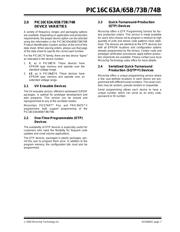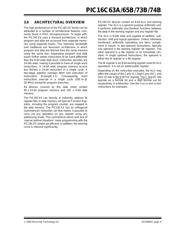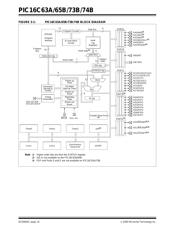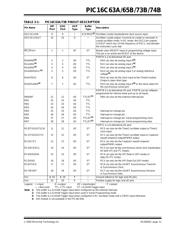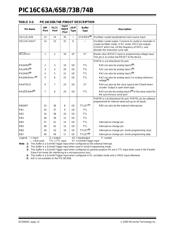Datasheet 搜索 > 微控制器 > Microchip(微芯) > PIC16C74B-04I/P 数据手册 > PIC16C74B-04I/P 数据手册 9/184 页
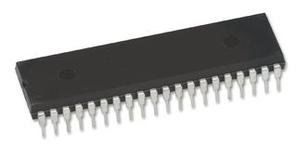
 器件3D模型
器件3D模型¥ 26.396
PIC16C74B-04I/P 数据手册 - Microchip(微芯)
制造商:
Microchip(微芯)
分类:
微控制器
封装:
DIP-40
描述:
MICROCHIP PIC16C74B-04I/P 微控制器, 8位, 一次性可编程, PIC16C7xx, 4 MHz, 7 KB, 192 Byte, 40 引脚, DIP
Pictures:
3D模型
符号图
焊盘图
引脚图
产品图
页面导航:
引脚图在P11P12P13P51P52Hot
原理图在P10P29P31P33P34P37P39P44P47P51P52P55
标记信息在P153P154
封装信息在P153
功能描述在P2P5
技术参数、封装参数在P98P123P124
导航目录
PIC16C74B-04I/P数据手册
Page:
of 184 Go
若手册格式错乱,请下载阅览PDF原文件

2000 Microchip Technology Inc. DS30605C-page 9
PIC16C63A/65B/73B/74B
3.0 ARCHITECTURAL OVERVIEW
The high performance of the PIC16CXX family can be
attributed to a number of architectural features com-
monly found in RISC microprocessors. To begin with,
the PIC16CXX uses a Harvard architecture, in which
program and data are accessed from separate memo-
ries using separate buses. This improves bandwidth
over traditional von Neumann architecture, in which
program and data are fetched from the same memory
using the same bus. Separating program and data
buses further allows instructions to be sized differently
than the 8-bit wide data word. Instruction opcodes are
14-bits wide, making it possible to have all single word
instructions. A 14-bit wide program memory access
bus fetches a 14-bit instruction in a single cycle. A
two-stage pipeline overlaps fetch and execution of
instructions (Example 3-1). Consequently, most
instructions execute in a single cycle (200 ns @
20 MHz) except for program branches.
All devices covered by this data sheet contain
4K x 14-bit program memory and 192 x 8-bit data
memory.
The PIC16CXX can directly, or indirectly, address its
register files or data memory. All Special Function Reg-
isters, including the program counter, are mapped in
the data memory. The PIC16CXX has an orthogonal
(symmetrical) instruction set that makes it possible to
carry out any operation on any register using any
addressing mode. This symmetrical nature and lack of
‘special optimal situations’ make programming with the
PIC16CXX simple yet efficient. In addition, the learning
curve is reduced significantly.
PIC16CXX devices contain an 8-bit ALU and working
register. The ALU is a general purpose arithmetic unit.
It performs arithmetic and Boolean functions between
the data in the working register and any register file.
The ALU is 8-bits wide and capable of addition, sub-
traction, shift and logical operations. Unless otherwise
mentioned, arithmetic operations are two's comple-
ment in nature. In two-operand instructions, typically
one operand is the working register (W register). The
other operand is a file register or an immediate con-
stant. In single operand instructions, the operand is
either the W register or a file register.
The W register is an 8-bit working register used for ALU
operations. It is not an addressable register.
Depending on the instruction executed, the ALU may
affect the values of the Carry (C), Digit Carry (DC), and
Zero (Z) bits in the STATUS register. The C and DC bits
operate as a borrow
bit and a digit borrow out bit,
respectively, in subtraction. See the SUBLW and SUBWF
instructions for examples.
器件 Datasheet 文档搜索
AiEMA 数据库涵盖高达 72,405,303 个元件的数据手册,每天更新 5,000 多个 PDF 文件
